- within Corporate/Commercial Law and Law Department Performance topic(s)
- with Senior Company Executives, HR and Inhouse Counsel
- in Australia
- with readers working within the Aerospace & Defence, Banking & Credit and Business & Consumer Services industries
Game-changing the future
Part 2 – Understanding innovation
Overview
In Part One we looked at the need for Australia to innovate in order to address an underlying decline in productivity. In this publication we introduce the Business Model Canvas, a template for identifying the drivers of value and innovation within a business.
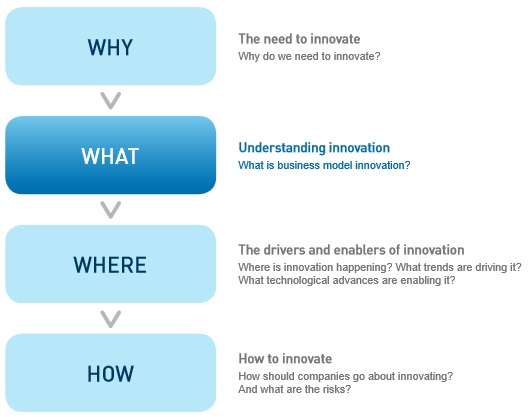
Understanding innovation
What is business model innovation? In order to answer this question, we need a framework to identify the key drivers of value within a business.
Introducing the Business Model Canvas
If business models are the recipe for creating value, what are the ingredients? The Business Model Canvas is a visual framework comprising nine segments, or building blocks, that enable us to identify the key drivers of innovation within an organisation.
The Business Model Canvas
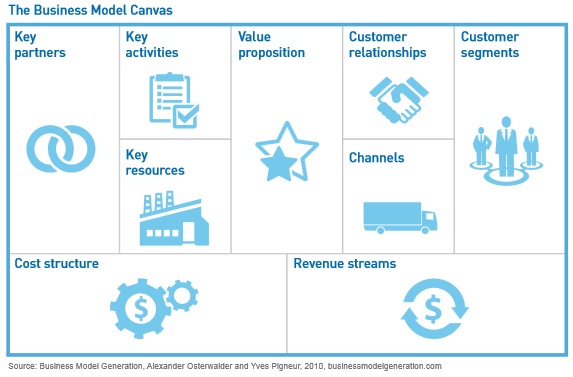
The nine building blocks represent three distinct segments of a business model.
The left segment comprises Key Partners, Key Activities, Key Resources, and Cost structure and represent the resources a company uses to deliver its services and products. It identifies how services and products are produced and the costs involved.

The right segment comprises Customer Relationships, Customers Segments, Channels and Revenue streams and represents who the business sells its services and products to, and how these are delivered to market.
The central building block, Value Proposition, describes the bundle of services and products that are offered by a business. It identifies what is offered to customers.
The Value Proposition
The Value Proposition describes the bundle of services and products that creates value for a Customer Segment. It is the reason customers choose one company over another. It solves a problem or satisfies a need. It may be quantitative (price, speed) or qualitative (design, customer experience).
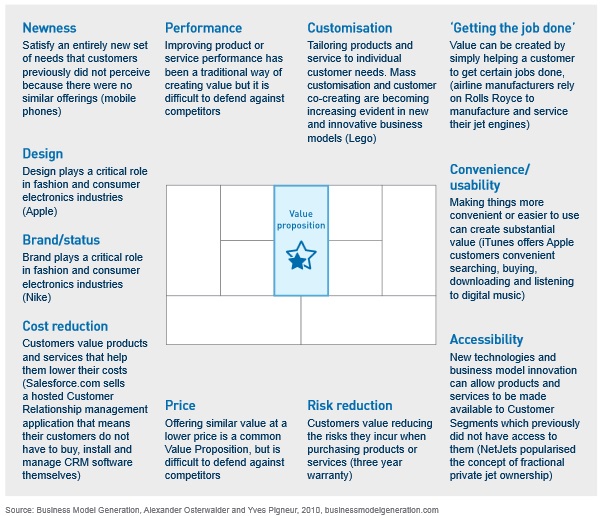
Creating value
Businesses create value (and create their Value Proposition) by leveraging Key Partnerships and Key Resources to perform Key Activities.
Key Partnerships
Key Partnerships are the network of suppliers and partners that make the business model work. There are three main motivations for creating partnerships.
Optimisation and economy of scale
Partnerships focused on reducing costs, and typically involve outsourcing or sharing infrastructure.
Reduction of risk and uncertainty
It is not unusual for competitors to form strategic alliances (Blu-ray was developed by a number of consumer electronic manufacturers acting cooperatively, but they still compete against each other in selling their own Blu-ray products).
Acquisition of particular resources and activities
Few companies own all the resources required by their business model. Rather than increasing their own resources and activities, they can outsource. Such partnerships can be motivated by the need to acquire knowledge, licenses or access customers (an insurer may rely on a network of independent brokers rather than an in house sales and marketing division).
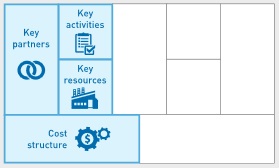
Cost Structure
Cost Structure identifies the most important costs incurred by a particular business model. Creating and delivering a Value Proposition incurs costs. These costs can be readily identified and are driven by Key Partnerships, Key Activities and Key Resources. Whilst costs are important for all businesses, they are critical for cost-driven business models such as low-cost airlines. These business models typically feature low price Value Propositions, high levels of automation and extensive outsourcing.
Economies of scale (cost advantages derived through volume) and economies of scope (costs advantages derived through multiple products or services being supported by a common infrastructure such as a marketing or distribution division) are a well known feature of many business models.
Creating value
Businesses create value (and create their Value Proposition) by leveraging Key Partnerships and Key Resources to perform Key Activities.
Key Activities
Key Activities represent the most important things a company must do to create and deliver its Value Proposition. Depending on the nature of the business, key activities could be:
- Production
Relates to designing, making and delivering a product (typical of manufacturing businesses) - Problem solving
Business models for consultancy and service businesses require new solutions for customer problems and require activities such as knowledge management and continuous training - Platform/network
Many technology businesses build their business model around a platform. (eBay is required to continually develop and maintain its website platform. This involves platform management, service provisioning and platform promotion)

Key Resources
Key Resources are the assets required to allow a business to create and deliver its Value Proposition. Key Resources can be owned, leased or acquired through Key Partners and typically comprise:
- Physical
Retailers such as Coles and Amazon.com rely heavily on physical resources such as buildings, point-of-sales systems and distribution networks. - Intellectual
Intellectual resources include brands, proprietary knowledge, patents and copyrights, partnerships and customer databases. Consumer goods businesses such as Nike and Sony rely heavily on brand as a Key Resource. Apple and MYOB depend on software and intellectual property developed over many years. - Human
All businesses require human resources, but these are particularly critical in knowledge-intensive and creative industries. (consultancies) - Financial
Financial resources can be used by non-financial businesses to support their Value Proposition. (Xerox financing)
Delivering value
Businesses deliver value (and deliver their Value Proposition) to Customer Segments through Customer Relationships and Channels.
Customer Relationships
Customer Relationships describes the type of relationship a company has with each of its Customer Segments. Relationships are critical for customer acquisitions, customer retention and upselling.
Customer Relationship can range from automated to personal:
- dedicated personal assistance
- personal assistance
- self-service
- automated services
Customer Segments
Customer Segments are the different customer groups a Value Proposition is directed towards. A customer group should be treated as an individual Customer Segment if:
- their needs require and justify a distinct offer
- they are reached through different Channels
- they require different types of Customer Relationships
- they have substantially different profitabilities
- they are willing to pay for different aspects of the Value Proposition
Customer segments include: mass market, niche, segmented, diversified and multi-sided
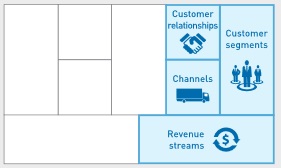
Channels
Channels are the routes through which a company delivers its Value Proposition. Channels are used as touch points with customers to:
- raise awareness about products and services
- help customers evaluate the Value Proposition
- facilitate the purchase of products and services
- deliver the Value Proposition to customers
- provide after-sales support
Companies can use their own channels or those of their partners. Owned channels include websites and retail networks. Partner channels include wholesale distribution, retail or partner-owned websites. Partner channels tend to have lower margins, but allow a company to expand its reach and benefit beyond its own infrastructure.
Revenue Streams
Revenue Streams represent the income generated from each Customer Segment. Each Revenue Stream may have a different pricing mechanism. Pricing mechanisms include Fixed 'Menu' Pricing (list price, product feature dependent, customer segment dependent, volume dependent) or Dynamic Pricing (negotiation, yield management, real time market and auctions).
The Business Model Canvas in action
Apple's iTunes store (in combination with its iconic iPod product) disrupted the music industry and quickly gave Apple a dominant position. Apple was not the first entrant into this market, but it was by far the most successful. We can apply the Business Model Canvas to identify the drivers of Apple's success.
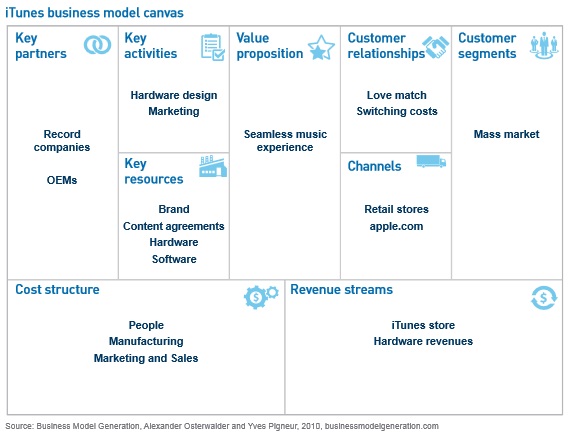
Unlike earlier market entrants such as Diamond Multimedia (Rio portable media players), Apple's Value Proposition offered a seamless music experience that combined well designed iPod hardware with a curated music purchasing experience via iTunes software and an online store. To deliver this Value Proposition, Apple had to negotiate content sharing agreements with the major record companies. In doing so it created a valuable asset – the world's largest online music library.
To cement its position, Digital Rights Management restrictions made it difficult for existing customers to switch to competitors who tried to subsequently emulate its business model. 1
Applying the Business Model Canvas
Once we understand how to identify the core components of business model innovation, we can apply this to understand and evaluate real life business models.
Epicentres of business model innovation
Business model innovations can arise from one or more epicentres. Whatever the starting point, they tend to have a transformative impact on most, if not all, aspects of a business. 2
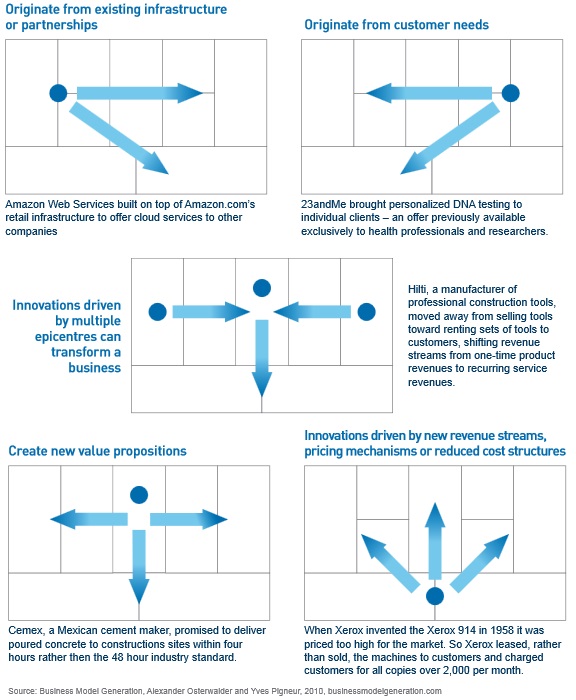
Case Study: Tata Motors – Building a new market place with a disruptive Value Proposition
In a country where the cheapest car was out of the reach of the vast majority of the population, India's Tata Motors democratised an iconic Western consumer product by building a car for USD $2,500. Tata Motors was only able to deliver this radical Value Proposition by re-inventing the traditional business model for automobile design, manufacture and distribution. 3 4
Tata reconceived how a car is designed, manufactured and distributed.
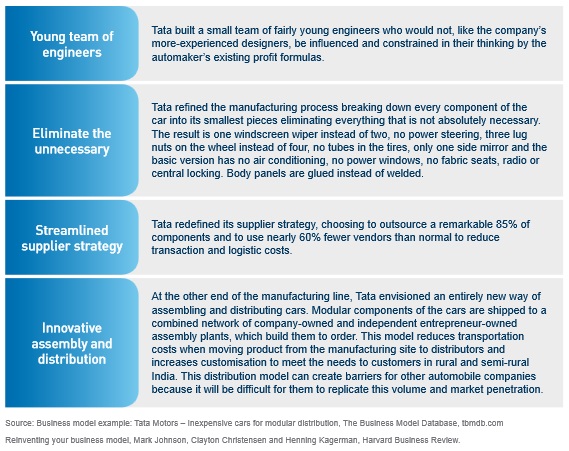
Tata Motors Business Model Canvas

Evaluating and improving business models – SWOT analysis
How do you assess a business model? How can you identify areas for improvement and innovation? Traditional SWOT analysis can be applied to the Business Model Canvas to reveal interesting paths to innovation and renewal. 5
SWOT analysis is a familiar and well-used strategic assessment tool. It asks four primary questions. What are your strengths and weaknesses? These prompt an evaluation of internal capabilities. And where are the opportunities and threats? These questions require us to consider an organisation's position within the external environment.
Applying SWOT analysis to the Business Model Canvas

These questions can be applied to each segment of the Business Model Canvas. By doing so, they provide an avenue for a structured consideration of an existing business model and may, in turn, provide the foundation for business model change and innovation. 6
Amazon.com
Applying SWOT analysis to Amazon.com 's Business Model Canvas in 2005 reveals both significant strengths and concerning weaknesses.

In 2005 Amazon.com recorded sales of US$8.5 billion as an online retailer. It had established itself as a pre-eminent retailer of books, music CDs and DVDs. In doing so, it had built significant strength in fulfillment excellence and, through economies of scale and investment in IT infrastructure, was able to reach a very large customer market in a cost efficient way.
Case study: Amazon.com
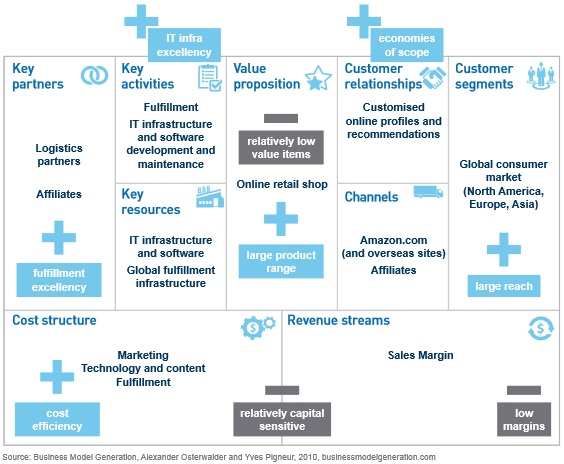
But margins were weak. By focusing on the sale of low-value, low-margin products such as books, CDs and DVDs, Amazon.com only achieved a net margin of 4.2% in 2005 from its sales of US $8.5 billion. By contrast, both Google and eBay achieved net margins of around 24% in that same year. 7
SWOT analysis revealed Amazon.com needed to lift its net margin. But how? The same analysis provided the answer. Amazon.com began to look for growth initiatives in higher - margin areas, and leveraged its key strengths in fulfillment excellence and IT infrastructure to identify these new opportunities.

Both initiatives leveraged Amazon's existing strengths and allowed further synergies to be achieved through the use of existing Key Activities and Key Resources to deliver two new Value Propositions to two new (and higher margin) Customer Segments. 8
Evaluating and improving business models – Blue Ocean Strategy
The old dichotomy of competing on either price or value is being dismantled. True innovation is not about competing on traditional performance metrics, but about creating new, uncontested markets. 9
Blue Ocean strategy is about simultaneously increasing value while reducing costs. This is achieved by identifying which elements of the Value Proposition can be eliminated, reduced, raised or newly created.
- Lower costs by reducing or eliminating less valued features or services.
- Enhance or create high-value features or services that do not significantly increase the cost base.
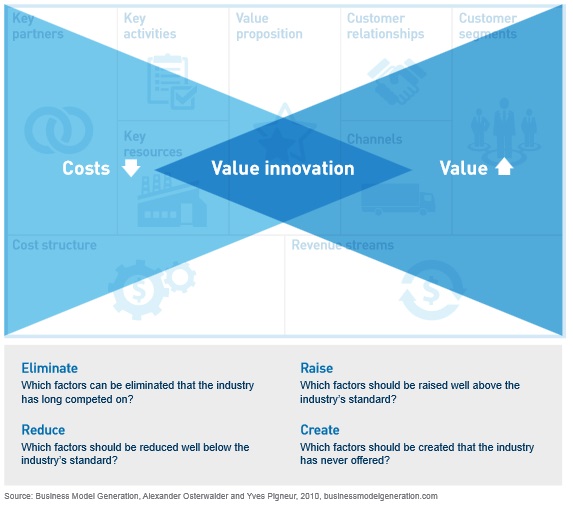
The Business Model Canvas can be used to identify Blue Ocean Strategy opportunities by considering opportunities for elimination, reduction, increase and creation) in each of the nine building blocks.
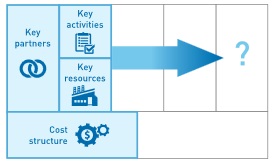 |
|
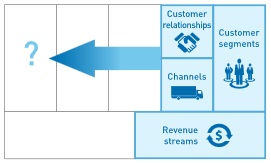 |
|
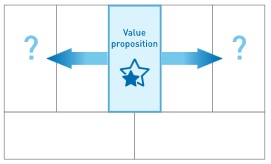 |
|
Case Study: Nintendo Wii
A combination of Blue Ocean Strategy and the Business Model Canvas highlights the fundamentally different business model Nintendo adopted to allow Wii to compete effectively against more powerful games consoles such as Sony's Playstation 3 and Microsoft's Xbox 360.
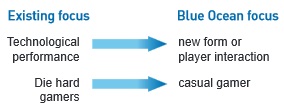
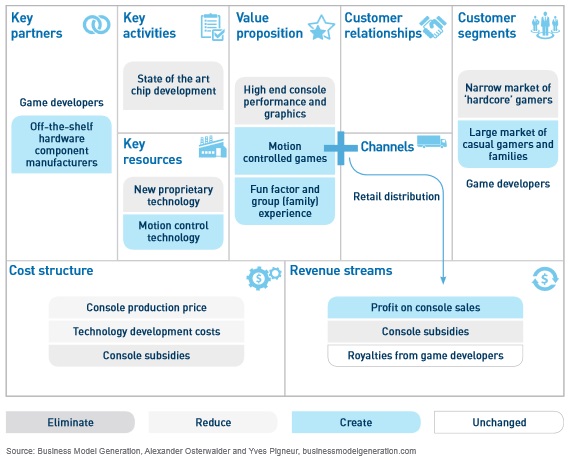
Looking forward
In Part Three of our series, we will identify some emerging business models that leverage key technological and consumer trends.
Looking forward
In Part Three of our series, we will identify some emerging business models that leverage key technological and consumer trends.

Footnotes
1 Business Model Generation ,
Alexander Osterwalder & Yves Pigneur, 2010.
businessmodelgeneration.com
2 Ibid
3 Business model example: Tata Motors – Inexpensive cars for
modular distribution, The Business Model Database . Web 17
April 2014
http://tbmdb.blogspot.com/2009/12/business-model-example-tata-motors.html
4 Reinventing your business model , Mark
Johnson, Clayton Christensen and Henning Kagerman, Harvard Business
Review
5 Business Model Generation , Alexander
Osterwalder & Yves Pigneur, 2010.
businessmodelgeneration.com
6 Ibid
7 Ibid
8 Ibid
9 Ibid
10 Ibid
The content of this article is intended to provide a general guide to the subject matter. Specialist advice should be sought about your specific circumstances.


